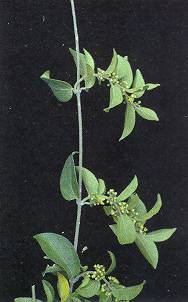
Other Common Names
Gurmarbooti
gurmar
Gymnema Sylvestre
| Back | Gymnema sylvestre |
Next |
Suja A |
 |
Other Common Names Gurmarbooti gurmar Gymnema Sylvestre |
Range: Deccan peninsula, Assam, and some parts of Africa.
Ecological status: Vulnerable
Gymnema sylvestre is a woody climbing plant that grows in the tropical forests of central and southern India. The leaves are used in herbal medicine preparations. G. sylvestre is known as "periploca of the woods" in English and mesbasringi (meaning "ram's horn") in Sanskrit. The leaves, when chewed, interfere with the ability to taste sweetness, which explains the Hindi name gurmar - "destroyer of sugar."
Plant part used : Leaves
Plant constituents include two resins (one soluble in alcohol), gymnemic acids, saponins, stigmasterol, quercitol, and the amino acid derivatives betaine, choline and trimethylamine.
Gymnema sylvestre is a stomachic, diuretic, refrigerant, astringent, and tonic. It has been found to increase urine output and reduce hyperglycemia in both animal and human studies.
Gymnema has been used in India for the treatment of diabetes for over 2,000 years. The primary application was for adult-onset diabetes, a condition for which it continues to be recommended today in India. The leaves were also used for stomach ailments, constipation, water retention, and liver disease.
Extracts of G. sylvestre given to patients with type I diabetes on insulin therapy reduces insulin requirements and fasting blood sugar levels, and improves blood sugar control. In a study of type II diabetics, Gymnema extract given along with oral hypoglycemic drugs was shown to improve blood sugar control and to either lead to discontinuation of the medicine or a significantly reduced dosage. It is interesting to note that Gymnema extract given to healthy volunteers does not produce any blood sugar-lowering, or hypoglycemic, effects.
Note : This has been compiled from various sources.